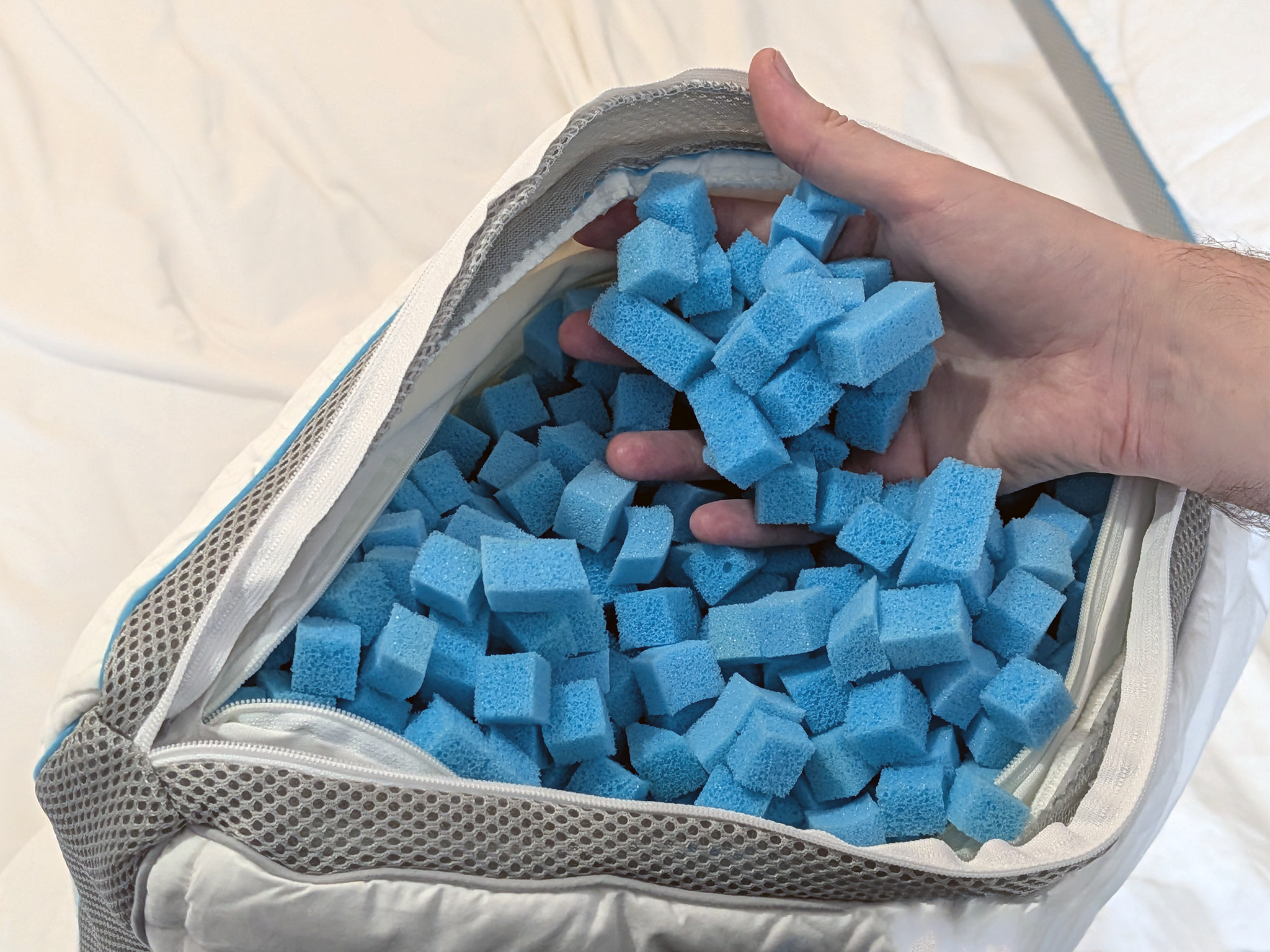
The quest for the perfect pillow can feel never-ending. One moment you're desperately flipping it to find the cool side, the next you're plumping it up to fend off a neck ache. If this nightly struggle sounds familiar, Simba’s Hybrid pillow might just be the solution you’ve been dreaming of.
Instead of a single, solid block of memory foam, this pillow is packed with hundreds of tiny, open-cell foam ‘nanocubes’. This is the core of its hybrid design: you get the malleable, cloud-like feel of a traditional down pillow, but with the consistent, pressure-relieving support of foam, so there’s no need for constant fluffing. Where things get clever is the pillow’s adjustability. You can unzip the cover and add or remove handfuls of these nanocubes to dial in the perfect height and firmness for your sleeping style, making it a potential one-size-fits-all solution.
To tackle overheating, Simba has infused the cover with its temperature-regulating technology, designed to actively draw heat away from you as you sleep. It’s a pillow that promises a lot, but can it deliver a truly restful night? We put it to the test to find out.
How I tested
I put Simba's claims to the ultimate long-term test by sleeping on the Hybrid pillow every night for 10 months, through the heat of summer and the chill of winter. Beyond just sleeping, I occasionally used it for back support while working from bed. My review focused on a handful of key criteria.
- Comfort: I assessed the overall comfort of the pillow, considering both the fill and its adjustable firmness. By adding and removing the internal foam ‘nanocubes’, I tested how easy it was to find the perfect height and density for my personal preference, judging how supportive it felt for my head and neck throughout the night.
- Temperature: One of Simba’s biggest claims is its temperature regulation. I paid close attention to how well the pillow dealt with heat during hot summer nights to see if it delivered on its promise of a more comfortable (and less sweaty) sleep.
- Sleeping positions: Simba claims the pillow is suitable for any sleeping position, so I contorted myself into as many shapes as I could. I used it while sleeping on my back, side and front to gauge its support and comfort in each configuration.
- Care: A pillow is no good if it’s a pain to keep clean. I followed the laundry care instructions, washing the cover to see how well it held up over time and how easy it was to remove and put back on.
- Allergies: I considered the pillow’s hypoallergenic materials. Throughout the 10-month testing period, I looked out for any signs of irritation or allergic reaction to ensure it was a safe and comfortable option for sensitive users.
Why you can trust IndyBest reviews
Liz Dodd has been a regular contributor to IndyBest for more than 10 years. In that time she tested everything from travel gear to memory foam pillows, offering honest verdicts based on her real-world experience and thorough investigation. She’s reviewed pillows from top brands like Eve and even wrote our definitive guide to finding the best pillow for your sleeping position, so she knows how to get a good night’s sleep.
Simba hybrid pillow

Dimensions: 45cm x 70cm, 60cm x 60cm
Filling: Nanocube core
Cover: Cotton
Why we love it
- Endlessly adaptable
- Synthetic fill makes this pillow ideal for anyone who suffers from allergies
- Plenty of support
Firmness
Simba says the pillow is filled with “nanocubes” and uses “nanocube technology” to give you the perfect night’s sleep. But what does that mean? Unlike older pillows that use memory foam (usually made from a polymer known as polyurethane), Simba’s nanocubes are made from open-cell foam made up of lots of tiny sealed cells filled with air. They compress and bounce back with real spring, which makes the pillow feel more like a traditional feather or down fill, and less like you’re sleeping on a wedge of plastic.
In terms of firmness, it feels somewhere between a feather pillow and a memory foam pillow: the closest comparison we found was with a natural fibre like wool. There is plenty of support, particularly if you retain all the nanocubes and fluff them up occasionally, and your head doesn’t sink all the way to the mattress the same way it would with a down fill. But there is always a degree of give, which is particularly nice if you sleep on a firmer mattress and on your side (so you have a very low pillow).

Comfort
Sure, this pillow doesn’t have the sumptuous, hotel-style plumpness of a fully-lofted down pillow. But it also won’t give you chronic neck ache. The nanocube fill is a triumph: it is really comfortable and squishy. But where this pillow also shines is its climate control. Its two sides are made from different materials, and the turquoise-bordered side uses a technology Simba calls “stratos”. Microcapsules applied to the cover absorb, store and release body heat depending on how warm or cold you get.
The other side, with a silver border, is made from ethically sourced, breathable cotton. You can spot the difference between the two surfaces, but with a pillowcase on, you won’t feel any difference in texture. Our reviewers naturally gravitated to the climate-controlled blue side and never had an uncomfortable night’s sleep.
The thick mesh stripe that runs around the middle of the pillow keeps air circulating around the cubes, which contributes to the coolness.
Sleeping position
The amount of lift you get from this pillow is entirely customisable because you can move the cubes – or they seem to naturally drift – to where you most need them. You can even remove whole handfuls. So when Simba says this pillow is for every sleeping style, they’re not exaggerating.
I’m a side-front sleeper, so moved most of the nanocubes from the base of the pillow to the top to give me a wedge-shaped pillow with a low profile at the neck. Front sleepers might like to remove some of the nanocubes to drop the height even more, while back sleepers can retain all the nanocubes, and might like to open the pillow and move them around every week or so to keep maximum loft all over.
Adjusting the cubes is really simple: unzip the outer cover, then the inner cover, reach in and mess them up.

Allergies
The synthetic fill makes this pillow ideal for anyone who suffers from allergies and can’t sleep on a natural or traditional fill. The microfibre layer that sits between the cubes and the cover is also hypoallergenic, and the cover is really easy to take off and wash.
Eco-friendliness
Old-fashioned memory foam is shockingly bad for the environment, so it’s good to see that Simba is trying to innovate in this area as well. The foam used to make the nanocubes is produced without TCPP and other chemicals – including phosphate, parabens, biocides and persistent organic pollutants – while remaining fire-safe. As well as being better for the environment, this makes the foam easier to recycle.
Care
You can wash the cover but not the fill – the nanocubes, with their little air cells, would probably never recover from the shock. Because the quilting on the cover is comfortable and the cover itself is so easy to wash (in a machine up to 40 degrees C) we didn’t find we needed a pillow protector.
After almost a year of relentless side-sleeping and occasionally working from bed, I did find that some of the nanocubes in our test pillow lost their bounce. This was easy to fix by opening up the fill compartment and moving them around a little: it’s worth doing this every couple of weeks, or whenever you notice the pillow has lost its height.
Price
Costing more than £100, this is one of the pricier synthetic pillows on the market. But it doesn’t go near the dizzying cost of some high-end down pillows, which can easily cost upwards of £200. Given that the pillow gives you the benefits of a down pillow – loft and comfort – and the practicalities of a foam pillow, I think it’s reasonably priced.
It’s also endlessly adaptable: if you buy it when you’re pregnant and sleeping on your back, for example, you can adjust the fill later to suit it to side sleeping. If you’re injured and want a supportive pillow to aid recovery, you can buy it for that, then refill it with nanocubes when you’re back-to-back sleeping.
Buy now £109.00, Simbasleep.com
The verdict: Simba hybrid pillow
Of all the pillows I’ve tested – from the £300 down fills to the very best memory foam – this is the pillow I sleep on every night. It’s a brilliant pillow for active people who are prone to the odd neck or shoulder strain, or anyone with a pre-existing injury because it absolutely won’t exacerbate any damage.
It’s also supremely huggable – if you sleep on the climate-controlled side, you can snuggle your lower arm under its cotton base. A space-age pillow that lives up to its sci-fi promise.
Read our review of the Simba hybrid luxe mattress, which came top of our best mattresses guide







